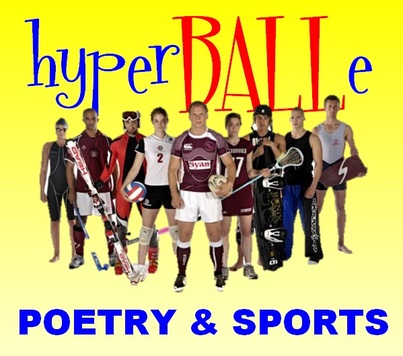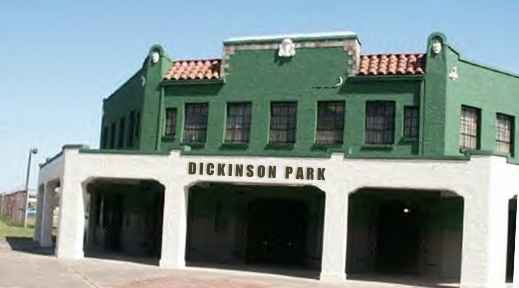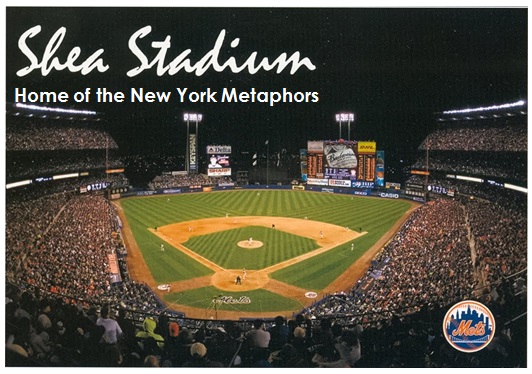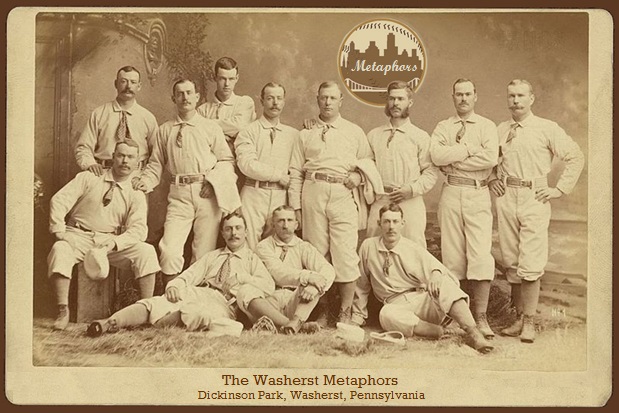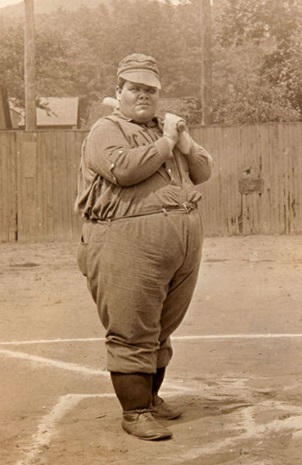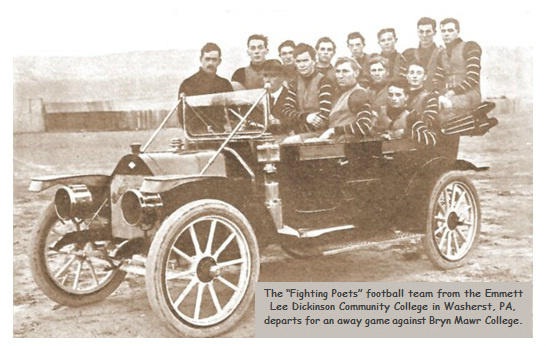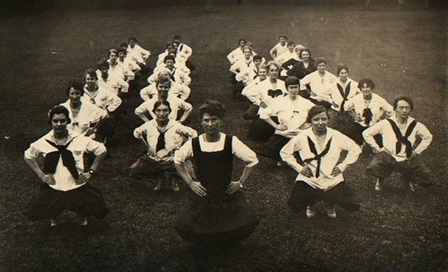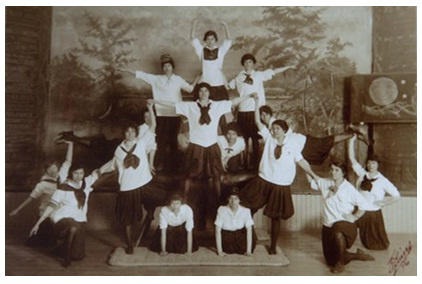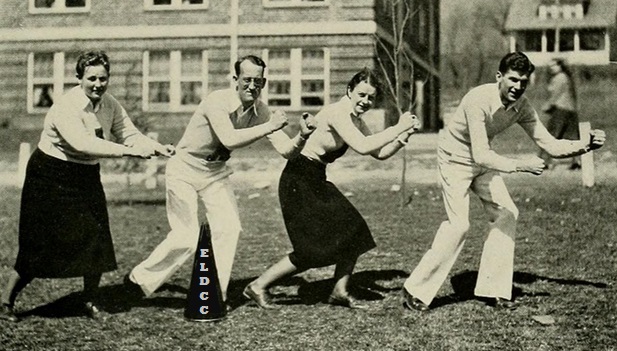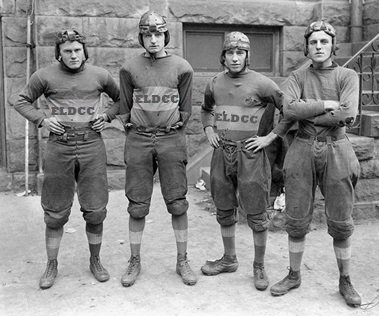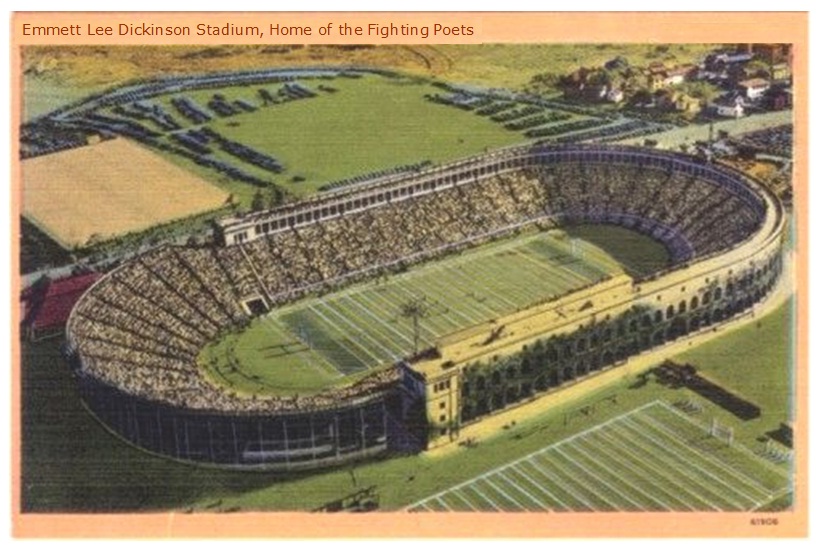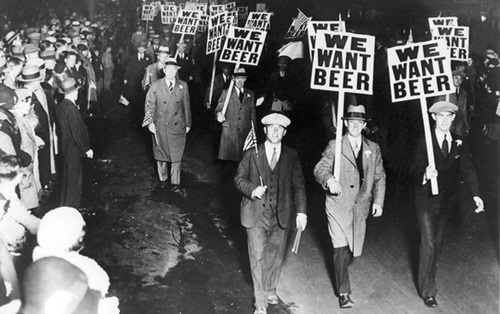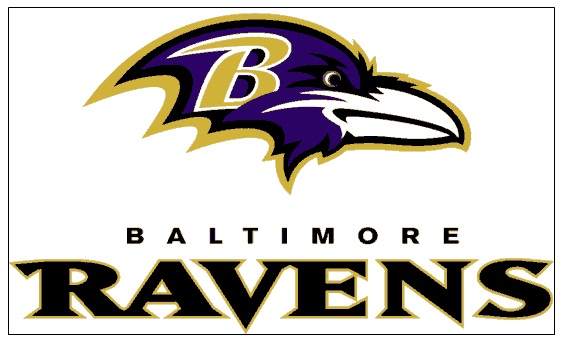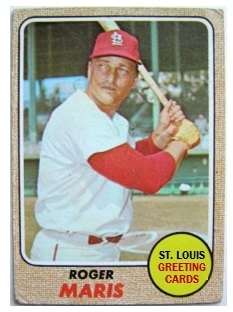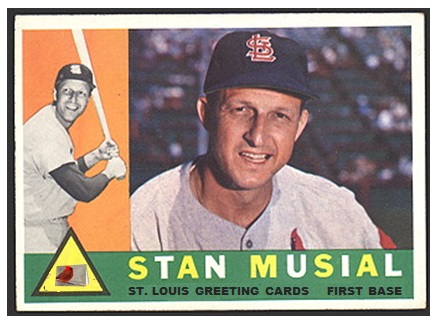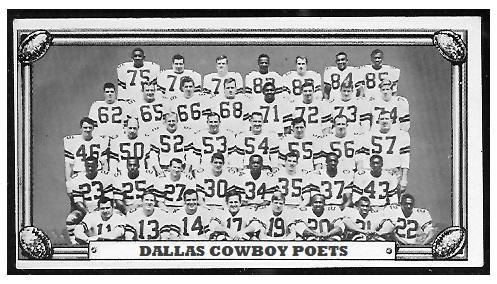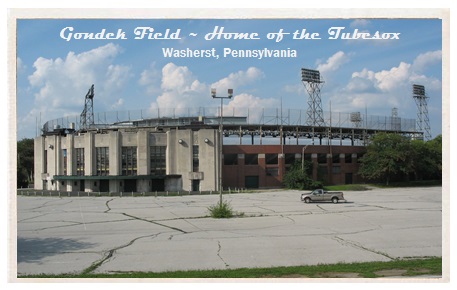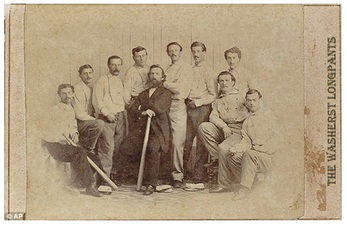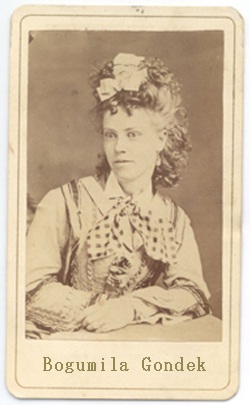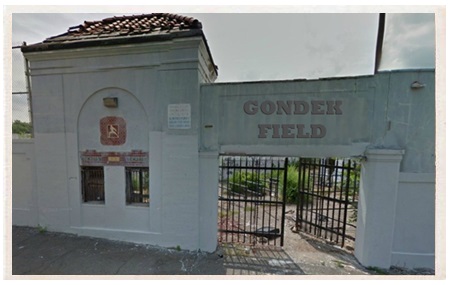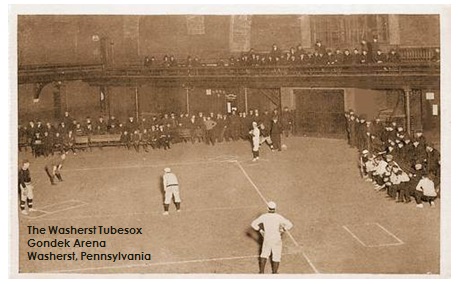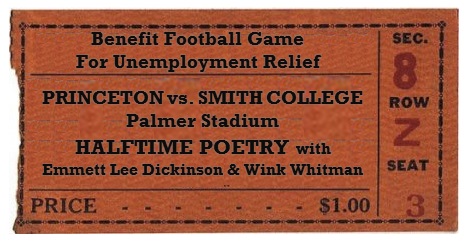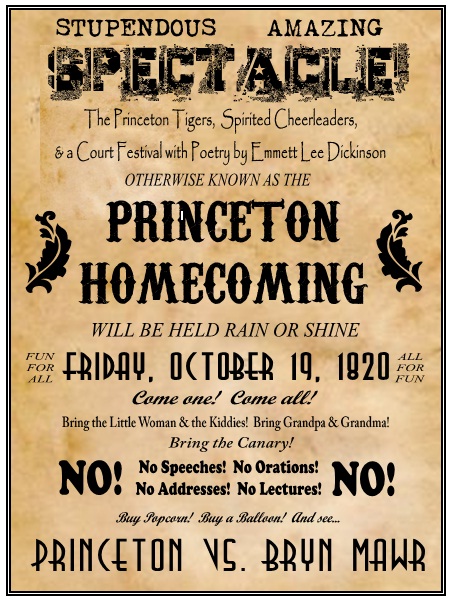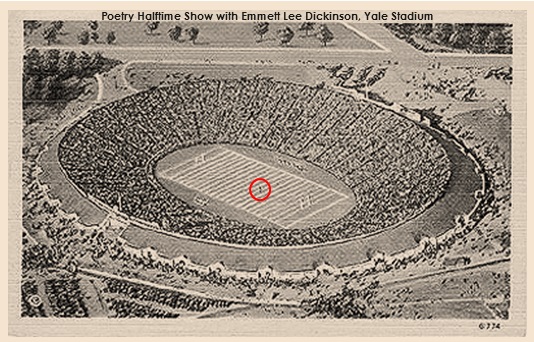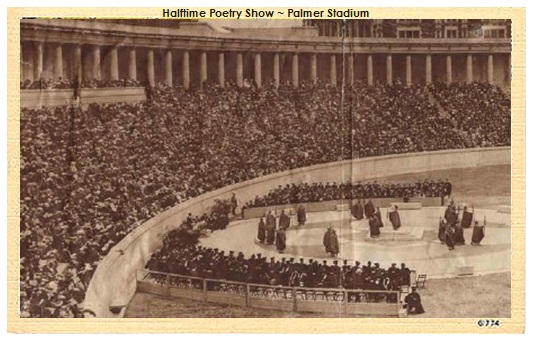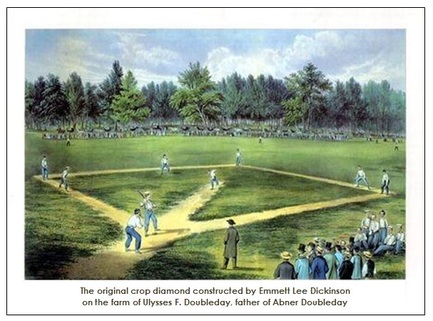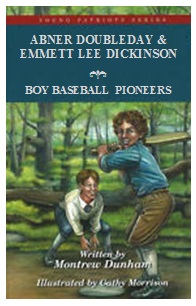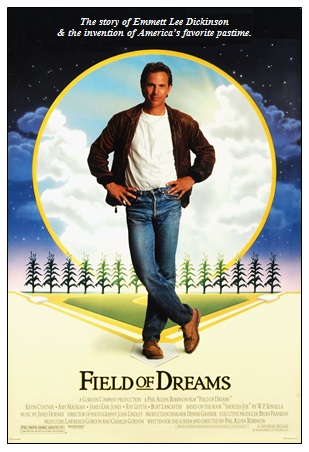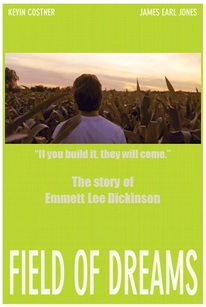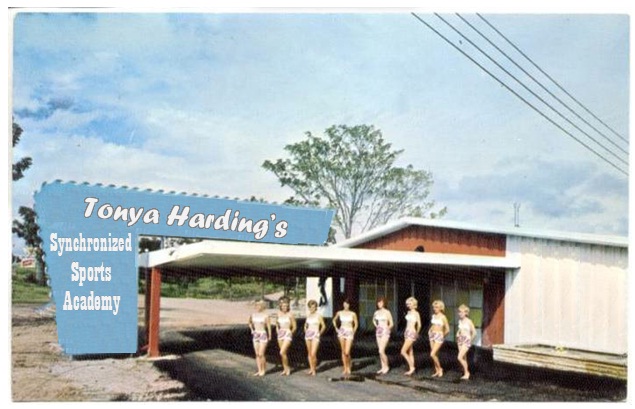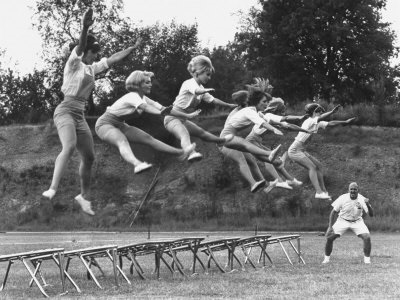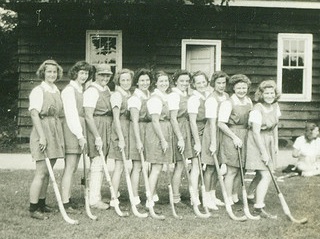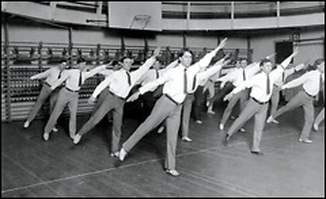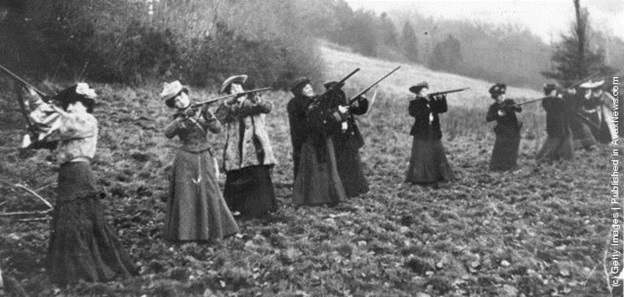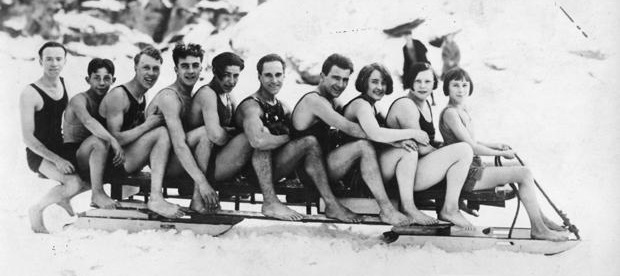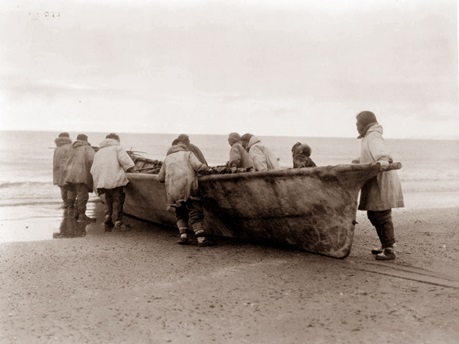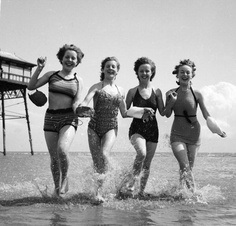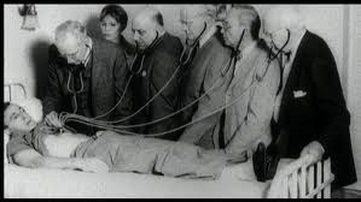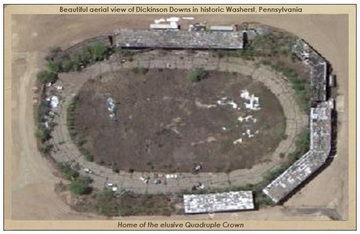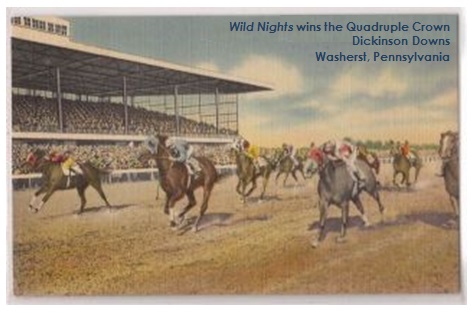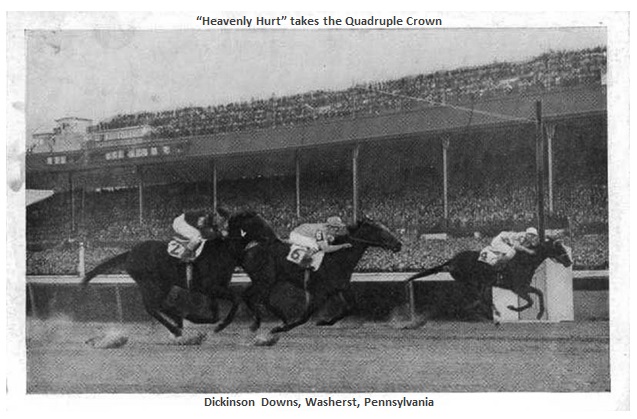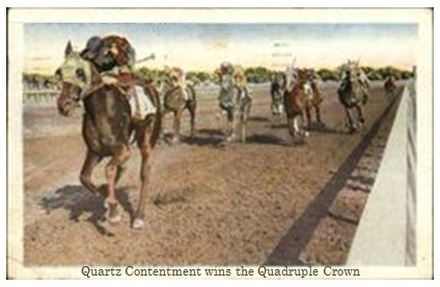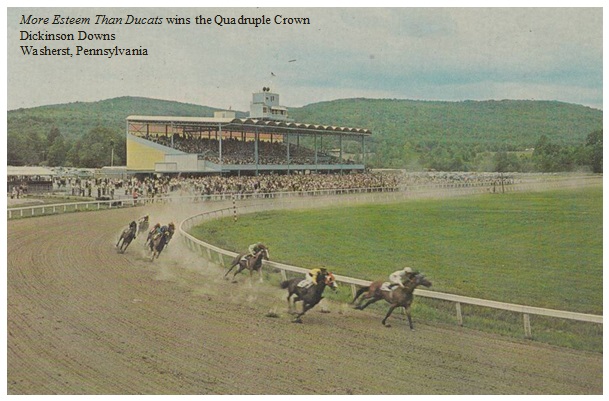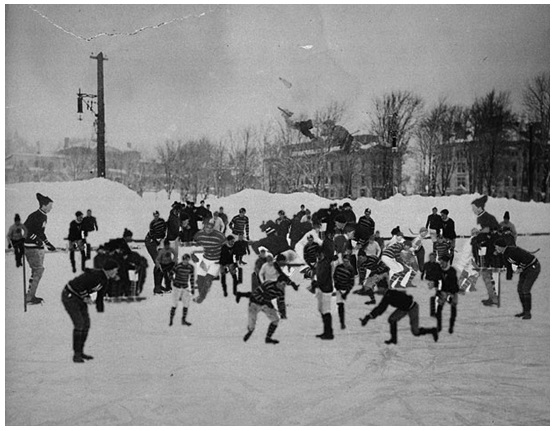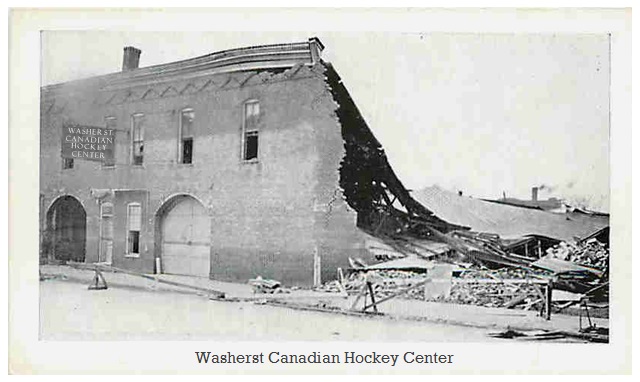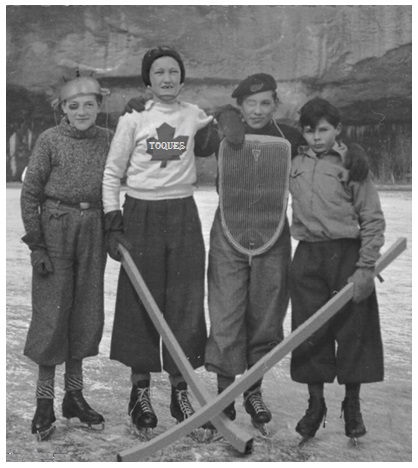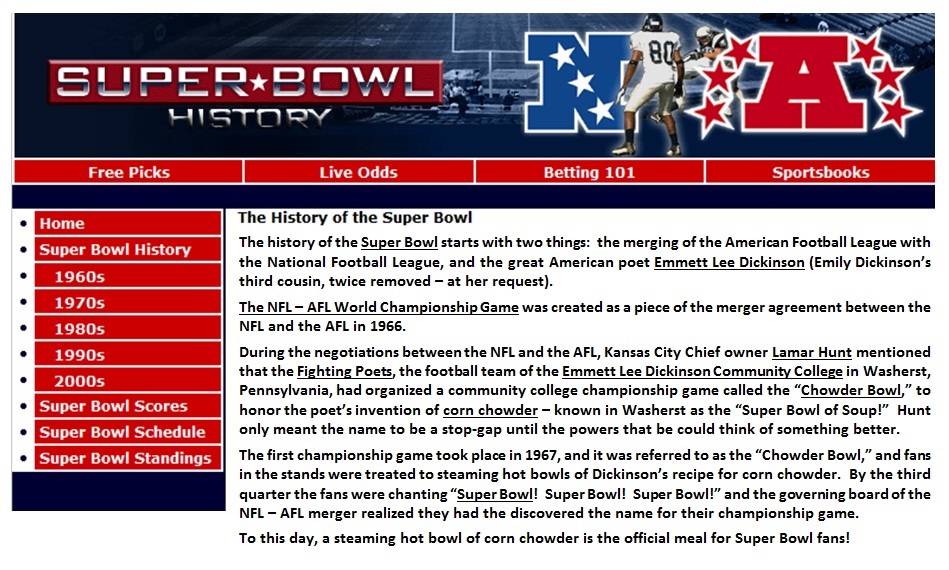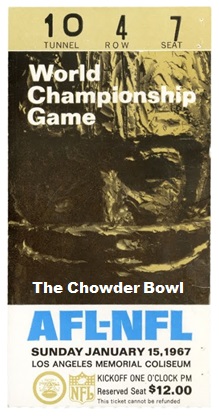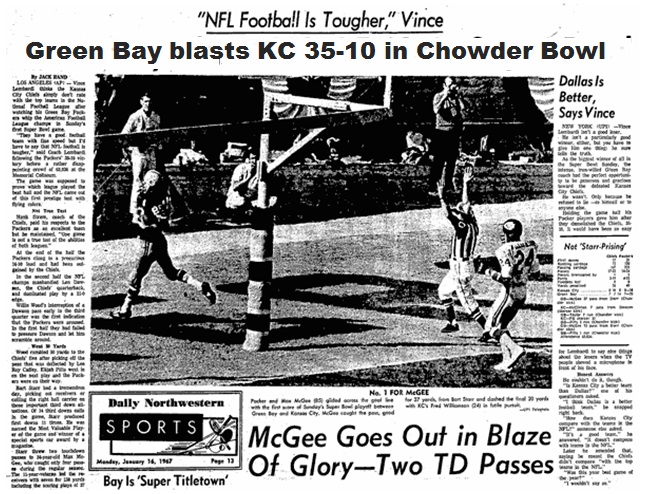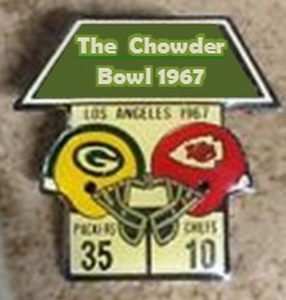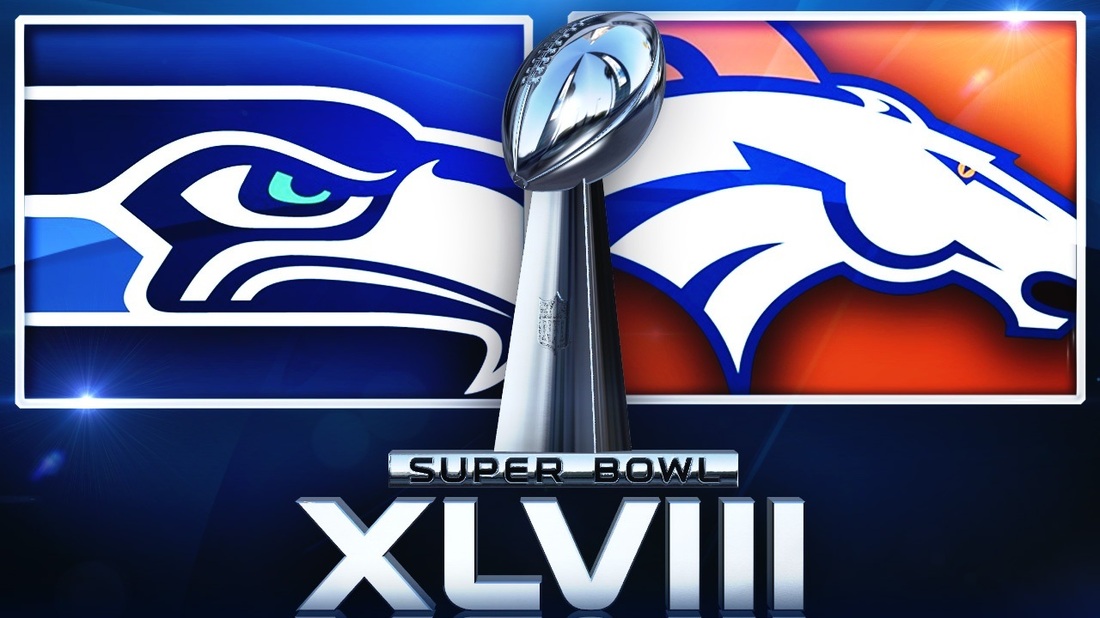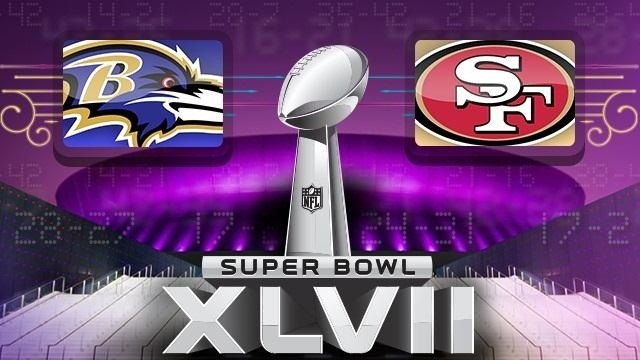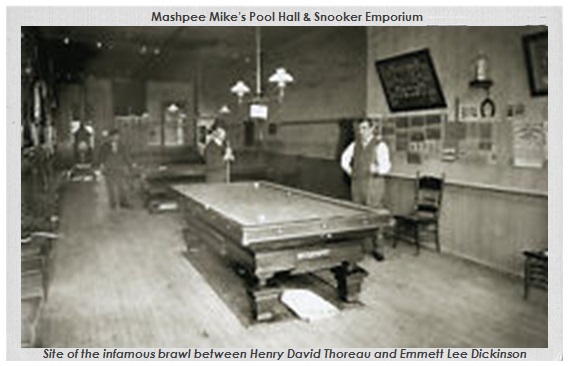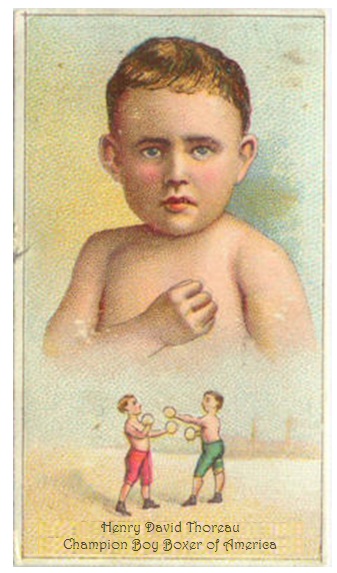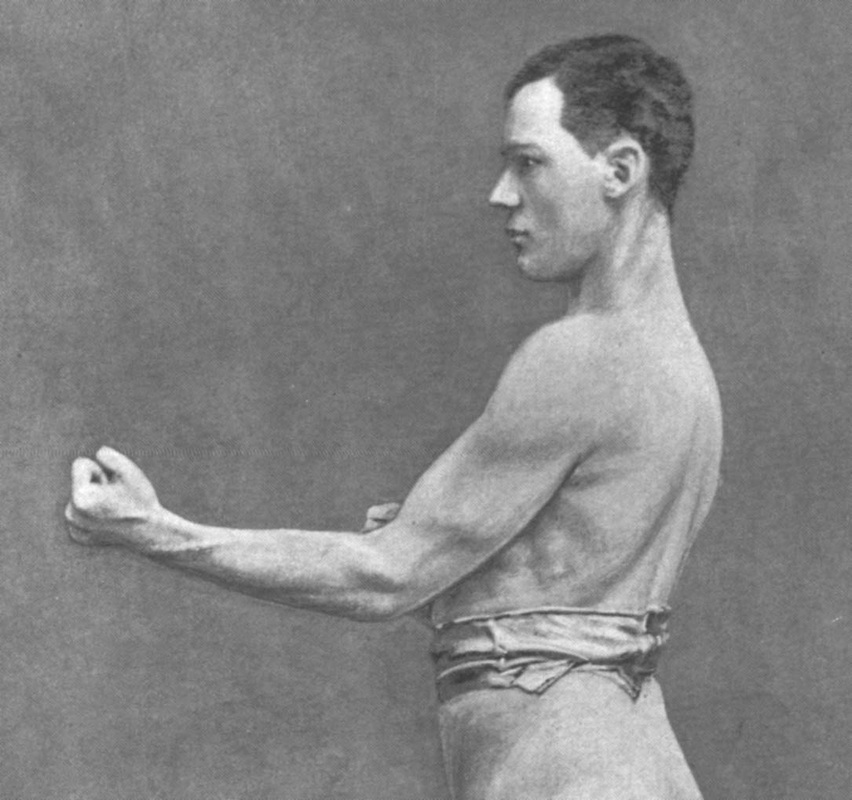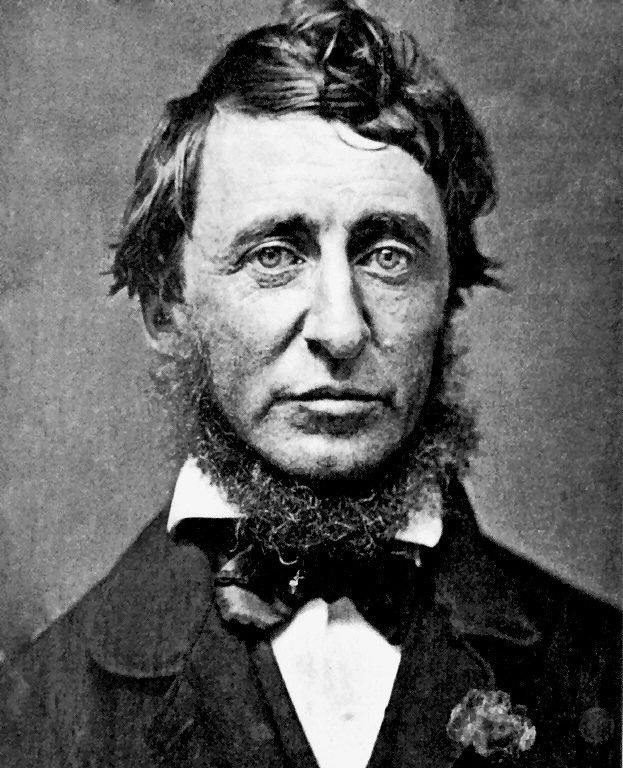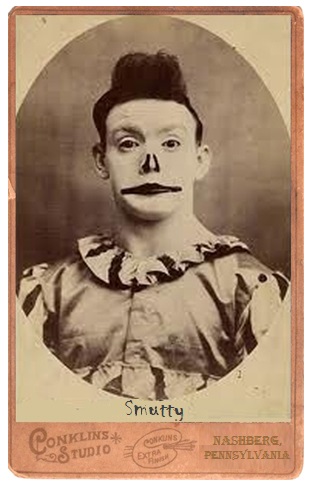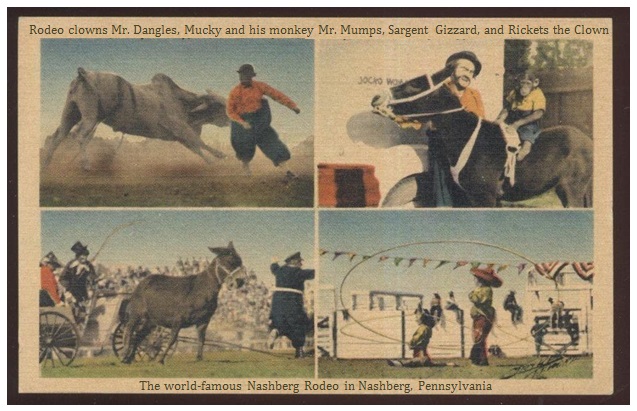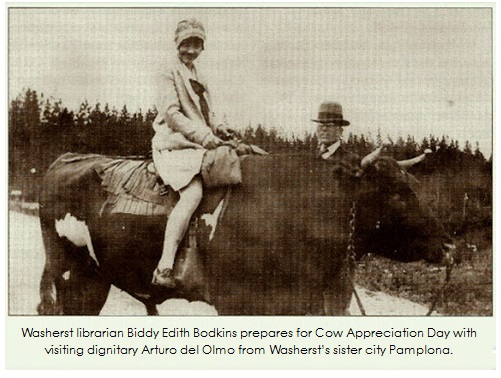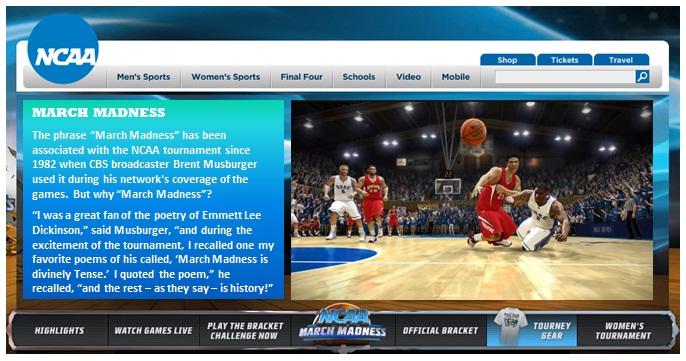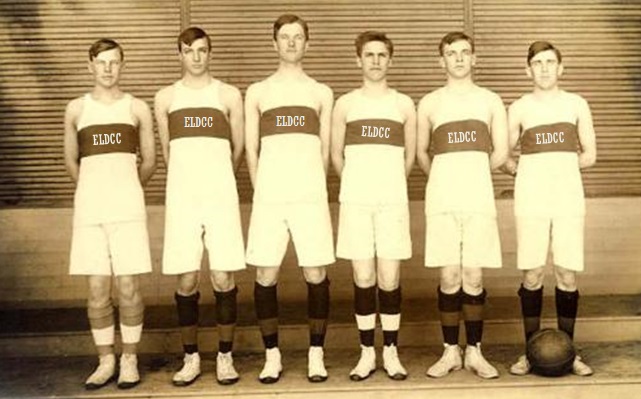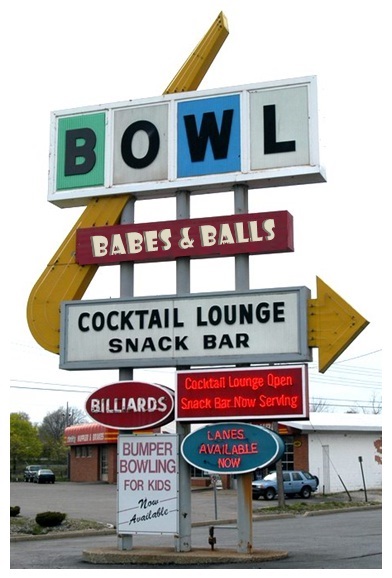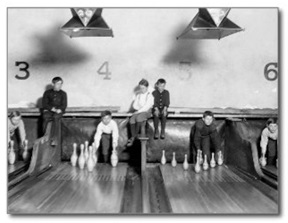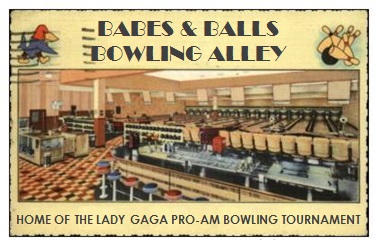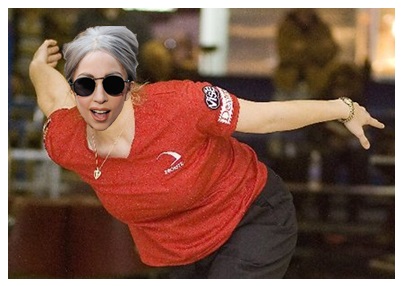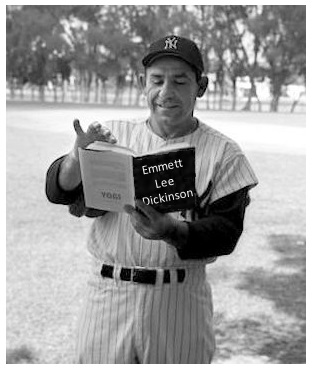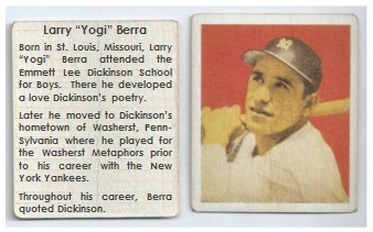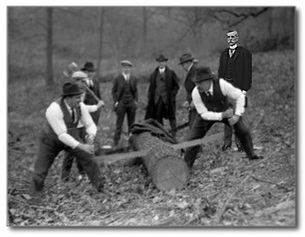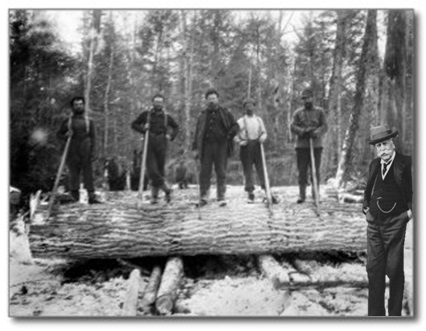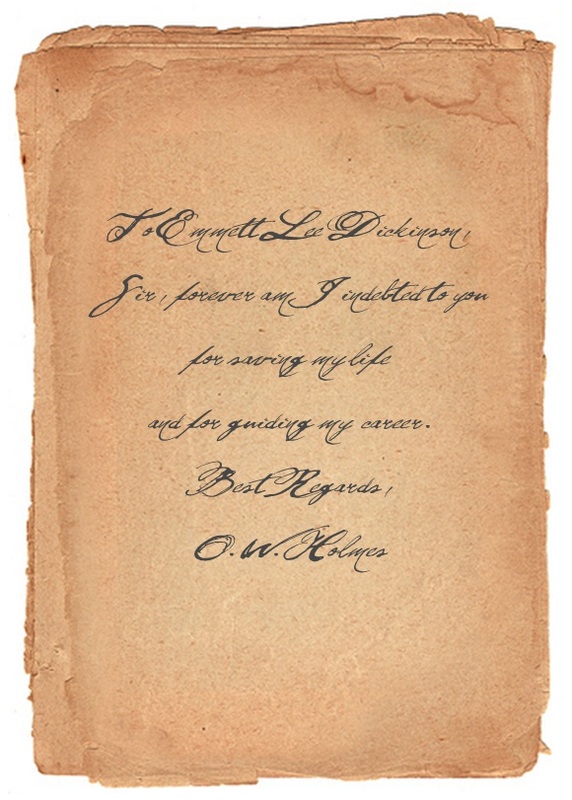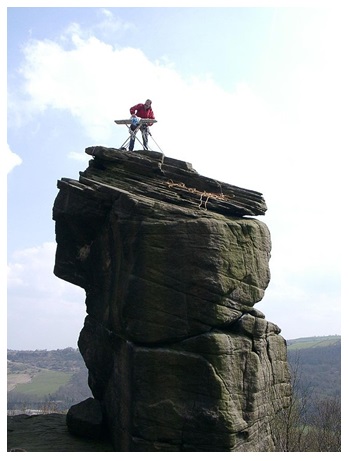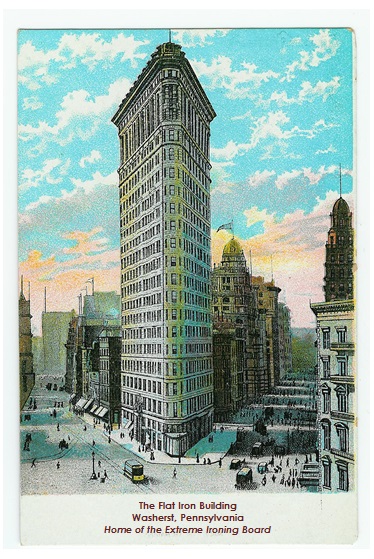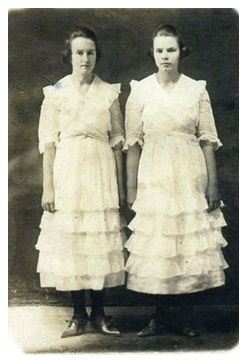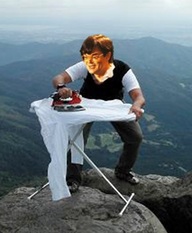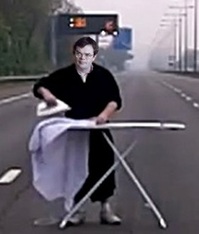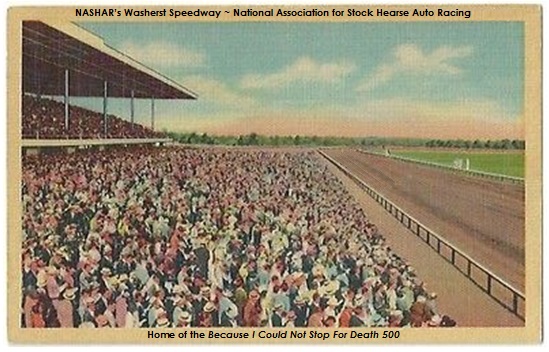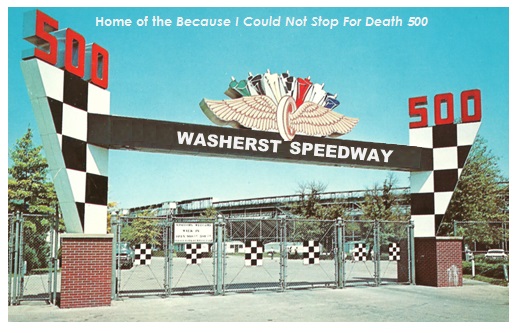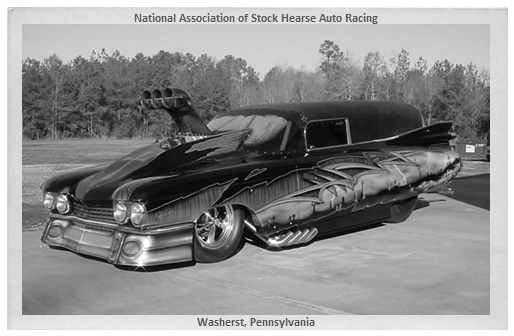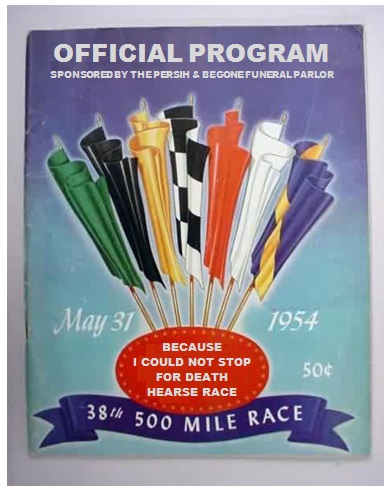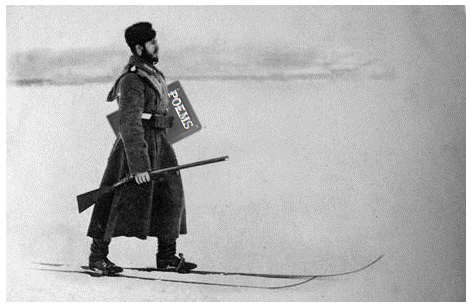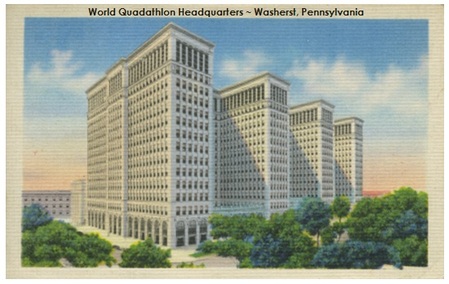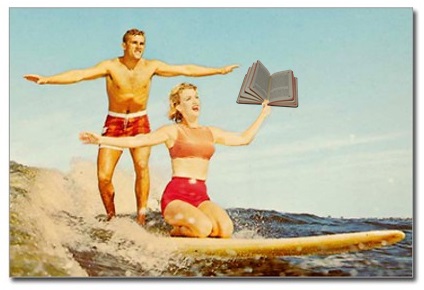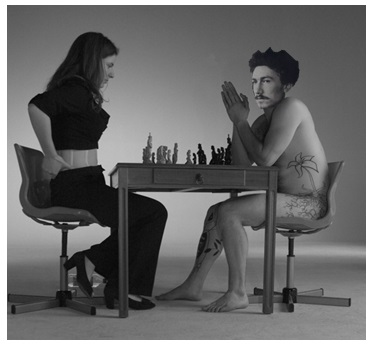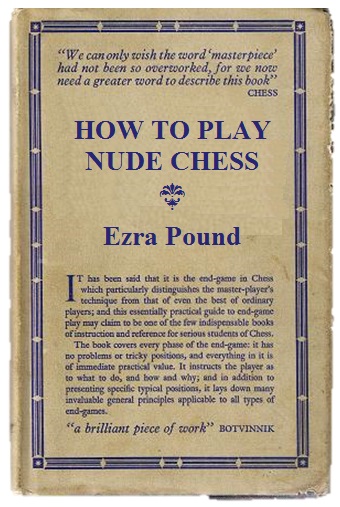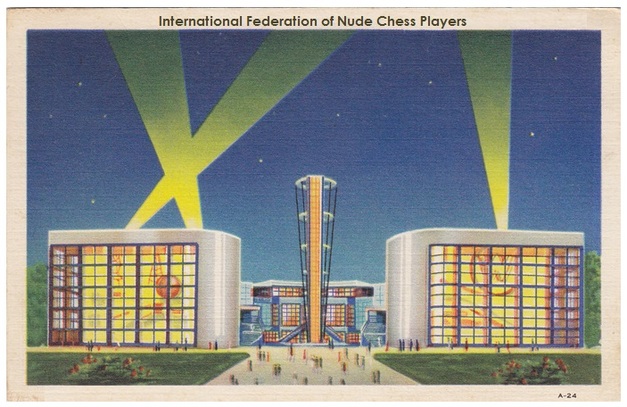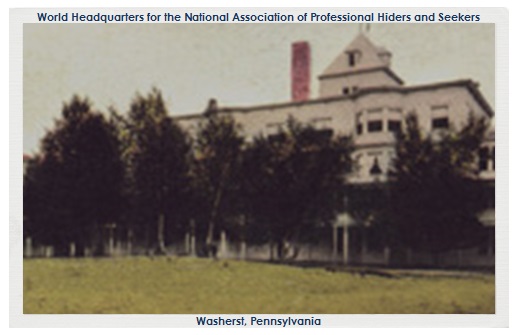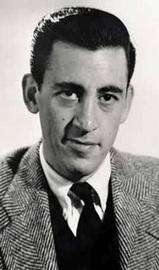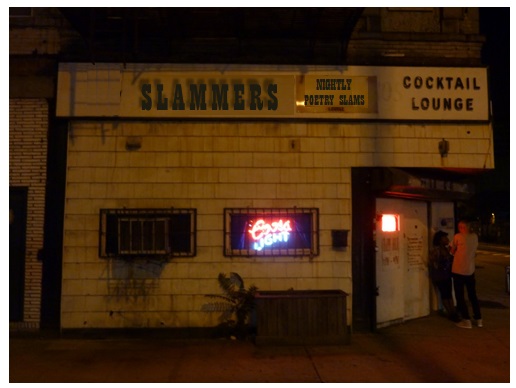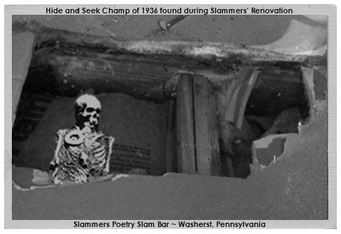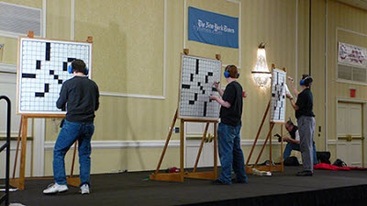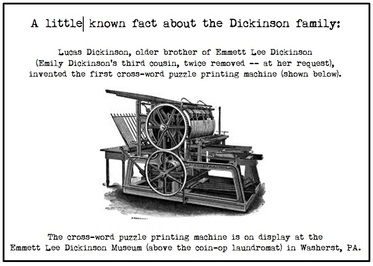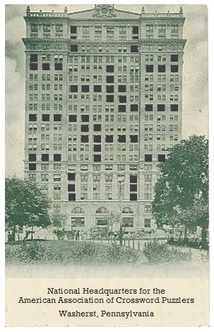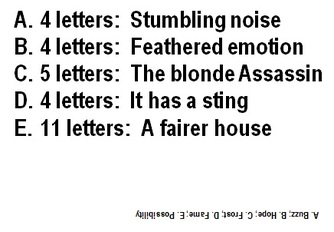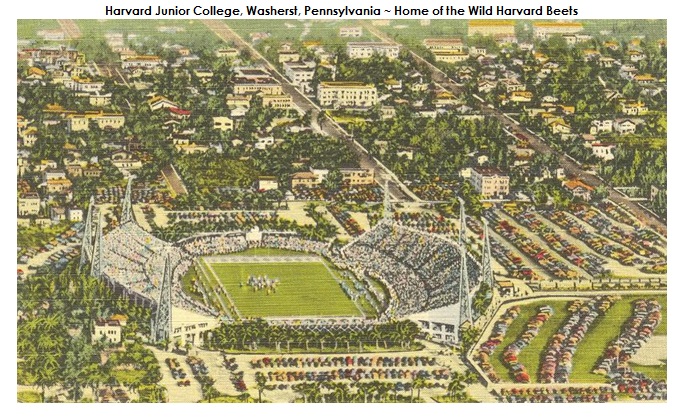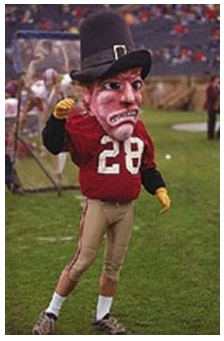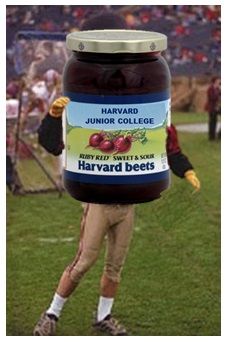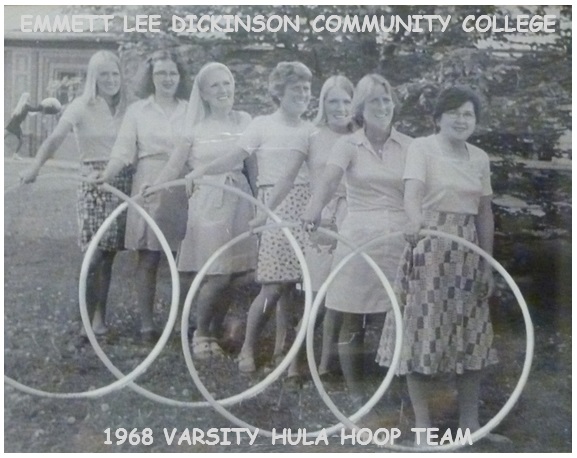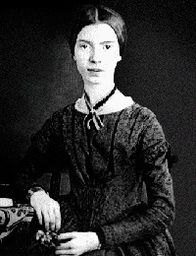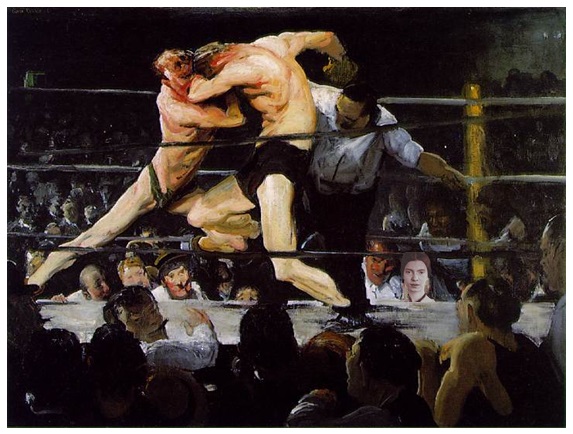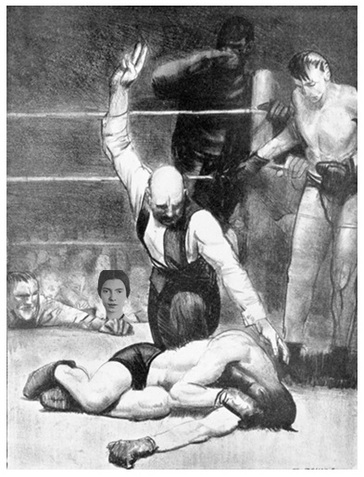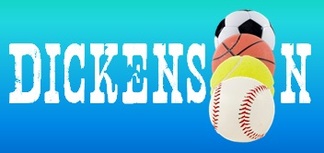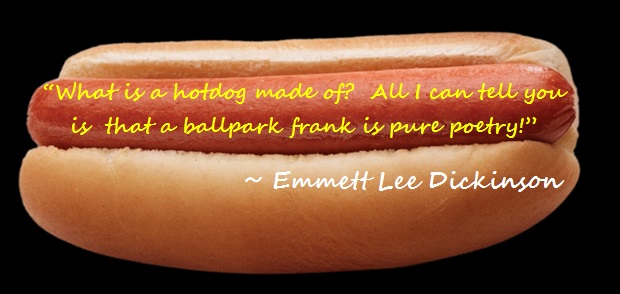June 1: The MetaphorsOf course, everyone knows of "the Mets," but did you know that the team's nickname was short for "the Metaphors"?
The team was first owned by Downing Walworth Mergan III, a sports fan and poetry aficionado, and he named the team "the Metaphors.' |
Pictured above: Shea Stadium, the home of the New York Metaphors.
Pictured at the right: Dickinson Park, the home of the Washerst Metaphors, the farm team for the NY Mets. |
|
Pictured above: A vintage photograph of the Washerst Metaphors.
Pictured at the right: Legendary Metaphor pitcher, Bonzo Mape. During the off-season, Mape served as a docent at the Poetry Hall of Fame in Washerst, PA. |
June 2: The Fighting Poets & the EmiliesMany teams have names derived from the elements of poetry or from the names of famous poets and/or their works (as we will highlight throughout the month), but one team name stems from America's greatest poet himself, Emmett Lee Dickinson (Emily Dickinson's third cousin, twice removed -- at her request) -- and that team is "the Fighting Poets" of Emmett Lee Dickinson Community College.
Pictured at the left: A vintage picture of Emmett Lee Dickinson Community College's Fighting Poets. |
|
Pictured at the right and below: The cheerleaders at Emmett Lee Dickinson Community College are called the "Emilies," named for Emmett Lee Dickinson's third cousin, Emily Dickinson, who was an avid football fan.
|
Pictured at the left: A favorite cheer of the Emilies was
"Let's get D - O - Double-U - N! Let's get down the field! Let's get D - O - Double-U - N! Let's get down the field!" |
Pictured below left: In 1922, due to students on academic probation, Emmett Lee Dickinson Community College's football team -- the Fighting Poets -- consisted of just four players. Pictured below center: Emmett Lee Dickinson Community College's Dickinson Stadium, home of the Fighting Poets. Pictured below right: Students enter Dickinson Stadium for a game against Mount Holyoke College.
June 3: Team Names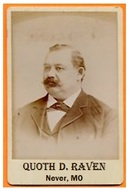
If it weren't for Quoth D. Raven of Never, MO, then Edgar Allan Poe might never have written his poem "The Raven" -- and if Poe hadn't written "The Raven," the Baltimore Ravens would be the Baltimore Bromo-Seltzers.
Pictured at the right: Quoth D. Raven from Never, MO. An account of Raven's encounter with Edgar Allan Poe is documented in Volume 1 of Great American Poems ~ REPOEMED. |
|
Many teams names have roots in poetry and verse. The St. Louis "Cardinals" were originally called the "Greeting Cards," and then the "Cards" for short. Their logo was a greeting card with a cardinal on it, so many people thought the team's name was the "Cardinals."
Pictured at the left and far left: Vintage baseball cards showing St. Louis' original team name, the Greeting Cards. The baseball card on the immediate left show's the team's original logo in the yellow triangle: a greeting card with a cardinal on it. |
June 4: Gondek Field & the TubesoxEmmett Lee Dickinson (Emily Dickinson's third cousin, twice removed -- at her request) was a great fan of baseball, and many a summer night he could be found in Gondek Field (the original -- not the modern, state-of-the-art stadium shown at the right).
Gondek Field was named for Mikolaj Gondek, the first manager of the Washerst Longpants (later the Washerst Tubesox). Gondek's wife, Bogumila, invented the tube sock worn by the team after several losing seasons because of their long pants. Pictured at the right: Gondek Field, one of the premiere baseball fields in the world, located in Washerst, PA. |
Below: In 1858, the Washerst Longpants changed their uniform -- and their name -- to Tubesox. That year, they won their first of many World Series championships. That championship inspired Emmett Lee Dickinson (Emily Dickinson's third cousin, twice removed -- at her request) to write the poem "One Game is left of the Series." His poem, in turn, inspired third cousin Emily to write "One Day is there of the Series" (the final stanza of Emmett Lee's poem also inspired another poem by third cousin Emily).
|
By Emmett Lee
Dickinson:
One Game is left of the Series Termed Post-Season Play Executed on the Diamond – Soon in Memory. Neither Pitcher nor Catcher I inspect the Sport Seems it to my Couched viewing And analysis of Score. Had there been one sharp Sacrifice Or an early Bunt – One less Strike or Foul – Might others be in front? Success will certainly count sweetest By those defeated today – Sorest comprehension for those Who lose the Play. |
By Emily Dickinson:
One Day is there of the Series Termed Thanksgiving Day. Celebrated part at Table Part in Memory. Neither Patriarch nor Pussy I dissect the Play Seems it to my Hooded thinking Reflex Holiday. Had there been no sharp Subtraction From the early Sum – Not an Acre or a Caption Where was once a Room – Not a Mention, whose small Pebble Wrinkled any Sea, Unto Such, were such Assembly ’Twere Thanksgiving Day. |
June 5: Halftime Poetry ShowsA sports-poetry connection many people don't know about today is the fact that early football halftime shows featured poetry readings.
Pictured at the right: A vintage poster for the Princeton homecoming game of 1820 which featured poetry read by Emmett Lee Dickinson (Emily Dickinson's third cousin, twice removed -- at her request). Today, Dickinson (who also invented marching bands) is known as "the Father of the Modern Football Halftime Show." |
Pictured below on the left: A very rare vintage postcard showing Emmett Lee Dickinson (in the read circle) reading poetry at the halftime show at a Yale-vs.-Wellesley College game at Yale Stadium
Picture below on the right: Halftime poetry shows became more and more elaborate through the years; the show in the antique postcard depicts the Princeton Poetry Alliance during their annual Poetry Spectacular at a game between Princeton and Agnes Scott College. Poetry pageants such as this later added marching bands, and that led to the modern halftime show.
Picture below on the right: Halftime poetry shows became more and more elaborate through the years; the show in the antique postcard depicts the Princeton Poetry Alliance during their annual Poetry Spectacular at a game between Princeton and Agnes Scott College. Poetry pageants such as this later added marching bands, and that led to the modern halftime show.
June 6: Baseball & DickinsonAlthough Abner Doubleday is often credited with inventing baseball, the sport really came about due to Abner's boyhood friend Emmett Lee Dickinson's fascination with crop diamonds (the precursor to crop circles). Dickinson constructed his first crop diamond in a cornfield on Abner's father's farm in Cooperstown, NY.
Pictured at the left: The original crop diamond constructed by Emmett Lee Dickinson on the farm of Ulysses F. Doubleday. |
Below left: Montrew Dunham's book on Abner Doubleday and Emmett Lee Dickinson and the invention of baseball.
Below center: The story of Emmett Lee Dickinson and Abner Doubleday (documented in Volume 1 of Great American Poems ~ REPOEMED) was turned into a major motion picture called "Field of Dreams" starring Kevin Costner as Emmett Lee Dickinson.
Below right: A movie poster for "Field of Dreams" with Kevin Costner in the classic pose of Emmett Lee Dickinson.
Below center: The story of Emmett Lee Dickinson and Abner Doubleday (documented in Volume 1 of Great American Poems ~ REPOEMED) was turned into a major motion picture called "Field of Dreams" starring Kevin Costner as Emmett Lee Dickinson.
Below right: A movie poster for "Field of Dreams" with Kevin Costner in the classic pose of Emmett Lee Dickinson.
June 7: Tonya Harding's Synchronized Sports AcademyWasherst, PA, the birthplace of America's greatest poet -- Emmett Lee Dickinson -- is also home to Tonya Harding's Synchronized Sports Academy.
After her involvement in the attack of Olypic skater Nancy Kerrigan, three years of probation and 500+ hours of community service, Tonya Harding moved to Washerst and became a professional wrestler. Harding wrestled for an organiation called "WOW" ("Wrestlers of Washerst") and appeared under the name of "Mean Maxine." Due to a soft and declining advertising market, though, "WOW" could not build and sustain any momentum. The organization halted their productions after just a dozen organized matches. In her work with "WOW," though, Harding recognized that a popular feature with the public was a segment of synchronized wrestling at each of the "WOW" events. |
Pictured above:
Tonya Harding's Synchronized Sports Academy |
Soon after "WOW" folded, Harding opened "Tonya Harding's Synchronized Sports Academy ," and it is now recognized as the premiere synchronized sports training center in the world. The academy offers training in sychronized chess, boxing, dwarf throwing, kabaddi (holding one's breath), dodgeball, luge, street luge, bowling, bridge, hunting, kayaking, and more!
Pictured below: Some of the most popular courses at Tonya Harding's Synchronized Sports Academy
|
Above: Dickinson Downs in historic Washerst, PA,
home of thoroughbred racing's Quadruple Crown. Click the image to enlarge. |
June 8: The Quadruple CrownThe Quadruple Crown of Thoroughbred Racing, commonly known as the “Quadruple Crown”, is a series of four Thoroughbred horse races for three-year-old horses run in May and early June of each year consisting of the Kentucky Derby, Preakness Stakes, Belmont Stakes, and the Washerst Derby.
At completion of the 2008 season, the four Quadruple Crown races have attracted more than 4,000 entrants. Of these, 274 horses have won a single leg of the Quadruple Crown, 50 horses have won two of the races, eleven horses have won three of the races, and only four have won the elusive "Quadruple Crown." The final race, the Washerst Derby, is run at beautiful Dickinson Downs in historic Washerst, Pennsylvania -- birthplace of Emmett Lee Dickinson (Emily Dickinson's third cousin, twice removed -- at her request). |
Pictured below: The only four horses to have won the elusive "Quadruple Crown":
Wild Nights, Heavenly Hurt, Quartz Contentment, and More Esteem Than Ducats.
Wild Nights, Heavenly Hurt, Quartz Contentment, and More Esteem Than Ducats.
June 9: Canadian HockeyDid you know that Canadian Hockey was invented by an American?
That's right! America's greatest poet, Emmett Lee Dickinson (Emily Dickinson's third cousin, twice removed -- at her request) created the game in the mid-1800s. Pictured at the left: Dickinson's original version of Canadian Hockey involved four teams that played each other simultaneously with three to six pucks at a time. As many as forty-eight people could be on the ice at once. Pictured below: The Washerst Canadian Hockey Center is the premiere training center for players of Canadian Hockey in the world. The center is known for its comprehensive training program for cultivating and advancing team rivalries. Every year, conflicts explode at the final practice until much of the building is destroyed. The rebuilding of the WCHC is a favorite annual tradition of Washerstians and Canadian Hockey enthusiasts. |
|
June 10: The Super BowlDid you know that the first Super Bowl was not called the Super Bowl? The first championship was called the Chowder Bowl as a tribute to Emmett Lee Dickinson (Emily Dickinson's third cousin, twice removed -- at her request).
Pictured at the left: "The History of the Super Bowl." Click the image to enlarge. Pictured below: Memorabilia from the 1967 Chowder Bowl (later referred to as Super Bowl I) on display at the Emmett Lee Dickinson Museum (above the coin-op Laundromat on Dickinson Boulevard). |
June 11: Super Bowl Poems
|
The Super Bowl, originally called the Chowder Bowl, is called the "Super Bowl" as a tribute to America's greatest poet, Emmett Lee Dickinson (Emily Dickinson's third cousin, twice removed -- at her request)) -- and oddly enough, many of Dickinson's poems , though written more than a century before the first AFL-NFL championship game, reference many of the match ups in Super Bowl history.
For example, the two poems below on the left -- written in the mid-19th century -- suggest the Super Bowl match up between the Seattle Seahawks and the Denver Broncos in 2014. The poems also inspired third cousin Emily to write the poems shown on the right. |
|
By Emmett
Lee Dickinson:
The Spirit is the Seahawk Cheer. We actually Hear When we inspect – what’s audible – They are committed – Here – In other Stadiums – as Sound -- There hangs a smaller Cheer Unlike Seattle – that Contains The record – we all – Hear – |
By Emily
Dickinson:
The Spirit is the Conscious Ear. We actually Hear When We inspect – that's audible – That is admitted – Here – For other Services – as Sound – There hangs a smaller Ear Outside the Castle – that Contain – The other – only – Hear – |
|
By Emmett
Lee Dickinson:
He rises – passes – toward the Goal Propels a perfect Pass – We cheer on Manning with his Spiral And more records are set |
By Emily
Dickinson:
It rises – passes – on our South Inscribes a simple Noon – Cajoles a Moment with the Spires And infinite is gone |
June 12: More Super Bowl PoemsAnother poem by Emmett Lee Dickinson (Emily Dickinson's third cousin, twice removed -- at her request) -- also written in the mid-19th century -- foreshadowed the Super Bowl match up between the Baltimore Ravens and the San Francisco Giants 2013. The poem also inspired third cousin Emily to write the poems shown on the right.
|
|
By Emmett Lee
Dickinson:
Forty-Niners in Gold and Ravens in Purple Leaping like Leopards to the Sky First and ten yards to the goal’s Horizon Letting a spotted Pass to fly Sacking as fast with the Defense’s blow Touchdowns are scored and kicking the Point Kickoffs down Field to the End Zone And the Super Bowl game is gone |
By Emily Dickinson:
Blazing in Gold and quenching in Purple Leaping like Leopards to the Sky Then at the feet of the old Horizon Laying her spotted Face to die Stooping as low as the Otter's Window Touching the Roof and tinting the Barn Kissing her Bonnet to the Meadow And the Juggler of Day is gone |
June 13: Dickinson & Thoreau; Pool & BoxingIn the mid-1800s, Henry David Thoreau worked as a pool hustler in Mashpee, Massachusetts. As a hustler, Thoreau encountered Emmett Lee Dickinson (Emily Dickinson's third cousin, twice removed -- at her request), and the two ended up in a bar room brawl at Mashpee Mike's Pool Hall and Snooker Emporium (pictured at the right).
This scuffle was immortalized in a song called “The Ballroom Blitz” (originally called "The Bar Room Blitz") released in 1975 by the glam rock band “Sweet.” The meeting of Dickinson and Thoreau is detailed in Volume 2 of Great American Poems ~ REPOEMED. |
|
|
Pictured at the far left: Henry David Thoreau's parents John Thoreau and Cynthia Dunbar had hoped that their son would grow up to be a championship boxer. As a youth, they entered him in contests up and down the east coast, and Thoreau became known as the "Champion Boy Boxer of America." Pictured at the top left: Henry David Thoreau in his early twenties when he boxed under the name David "Irish Mickey" Thoreau. He also worked as a pool hustler in Mashpee, Massachusetts. Pictured at the bottom left: Henry David Thoreau shortly after he retired from the New England Intercollegiate Boxing Federation. |
June 14: Rodeo ClownsEmmett Lee Dickinson's uncle Hobart Dicksinson owned a novelty shop in Washerst, PA. He also managed an entertainment partnership (with Dooley Dawson, known to the citizens of Washerst as “Doo-Daw”Dawson) that provided clowns, magicians, and balloon artists to children’s parties. Hobart Dickinson often performed at children's birthday parties as "Gurgles the Clown."
Hobart's oldest son, Fittleworth Dickinson, followed in his father's footsteps and worked as a clown named "Smutty" (the name his father had used occasionally when he appeared at parties as a mime). As "Smutty," Fittleworth Dickinson appeared as the first rodeo clown in the world-famous Nashberg Rodeo in nearby Nashberg, Pennsylvania. His work as a rodeo clown was so popular that soon other clowns followed in his footsteps, and employment opportunities in the area of rodeo buffoonery more than tripled in the late 1800s and early 1900s. |
|
Fittleworth Dickinson as "Smutty" began a new career industry as rodeo clown. Pictured at the right: World-famous rodeo clowns who followed in the footsteps of Fittleworth Dickinson: Top left: Horace Hewitson as Mr. Dangles. Top right: Lester Stapleton as Mucky the Clown (shown with is monkey Mr. Mumps) Bottom left: Levi Wharton as Sargent Gizzard Bottom right: H. P. Wakenshaw as Rickets the Clown |
June 15: The Running of the BullsThe running of the bulls in Pamplona is the most popular in Spain and has been broadcast live by RTVE, the public Spanish national television channel, for over 30 years. It is the highest profile event of the San Fermin festival, which is held every year from July 6–14 -- just days before Cow Appreciation Day in the United States, which is held on July 15.
To pay homage to poet Gelett Burgess, Emmett Lee Dickinson (Emily Dickinson's third cousin, twice removed -- at her request) established July 15th as “Cow Appreciation Day” (originally called “Purple Cow Appreciation Day”). The most popular tradition associated with Cow Appreciation Day is that local libraries around the county provide cow rides for "children of all ages." For more on the history of Cow Appreciation Day, click HERE. |
Pictured at the right: Washerst librarian Biddy Bodkins prepared for Cow Appreciation Day in the early 1900s when a visiting dignitary from Washert's sister city of Pamplona, Arturo del Olmo, was visiting. Del Olmo took news of Cow Appreciation Day back to Pamplona, and the city elders there developed similar traditions, including the running of the bulls.
June 16: NCAA's "March Madness"Pictured at the left: Sportscaster Brent Musburger's recollection of a poem by Emmett Lee Dickinson (Emily Dickinson's third cousin, twice removed -- at her request) brought the phrase "March Madness" to the NCAA's spring tournament. Click the image to enlarge.
Below left: Dickinson's poem, "March Madness is divinely Tense." Below right: Dickinson's poem inspired his third cousin Emily to write "Much Madness is divinest Sense." |
|
By Emmett Lee Dickinson:
March Madness is divinely Tense – To a devoted Fan – Elite Eight – the Final Four – Till the Championship In this, Hoop-Ball, triumph – Revelry – then restored to Sane – Depleted – you remunerate Wagers – Till bracketed with March again – |
By Emily Dickinson:
Much Madness is divinest Sense – To a discerning Eye – Much Sense – the starkest Madness – 'Tis the Majority In this, as All, prevail – Assent – and you are sane – Demur – you're straightway dangerous – And handled with a Chain – |
June 17: More March Madness PoetryNot only did Emmett Lee Dickinson (Emily Dickinson's third cousin, twice removed -- at her request) foresee the coming of the NCAA March Madness tournament, but the school that bears his name -- Emmett Lee Dickinson Community College -- has won the tournament many times.
Pictured at the right: The 1910 Emmett Lee Dickinson Community College basketball team not only one the NCAA March Madness tournament, but they did so following an undefeated season. Below left: Dickinson's poem, "The first Round's Game had come." Below right: Dickinson's poem inspired his third cousin Emily to write "The first Day's Night had come." |
|
By Emmett Lee Dickinson:
The first Round’s Game had come – Ungrateful that a team So terrible – had thus endured – And wiped my Bracket clean – So Sweet Sixteens were played – My Teams – to Atoms blown And so to mend it – gave me bets For still another Morn – And then – a Game as huge With Elite Eights in pairs, Unrolled a horror in my face – Each loss had blocked my lines – My Brain – begun to laugh – I mumbled – like a fool – And through the Final Four – that Day – My Brain kept giggling – still. And Something’s odd – within – The teams that I had bet – And this One – were just not the same – Could it be Madness – this? |
By Emily Dickinson:
The first Day's Night had come – And grateful that a thing So terrible – had been endured – I told my Soul to sing – She said her Strings were snapt – Her Bow – to Atoms blown – And so to mend her – gave me work Until another Morn – And then – a Day as huge As Yesterdays in pairs, Unrolled its horror in my face – Until it blocked my eyes – My Brain – begun to laugh – I mumbled – like a fool – And tho' 'tis Years ago – that Day – My Brain keeps giggling – still. And Something's odd – within – That person that I was – And this One – do not feel the same – Could it be Madness – this? |
June 18: Bowling & DickinsonBesides being the birthplace to poet Emmett Lee Dickinson (Emily Dickinson's third cousin, twice removed -- at her request), Washerst, PA, is also home to one of the world's most famous bowling alleys, the Babes & Balls Bowling Alley, home to the annual Lady Gaga Pro-Am Bowling Tournament.
There are still more connections to bowling & Dickinson: 1) Emmett Lee Dickinson created the profession of pin setter, which he called "Couplets," because two pin setters would sit together at the end of each bowling lane. Pictured below: "Couplets," a profession begun by Emmett Lee Dickinson, sat in pairs above bowling lanes and reset pins between frames.
|
June 19: Yogi Berra
|
Many athletes have been influenced by Emmett Lee Dickinson (Emily Dickinson's third cousin, twice removed -- at her request), but none more than Yogi Berra.
Berra developed his love of Dickinson when he attended the Emmett Lee Dickinson School for Boys in St. Louis, MO, and throughout his career, Berra quoted many of Dickinson's most famous quips. As a result, many of Dickinson's witticisms are now attributed to Berra. For more information on the connection between Yogi Berra and Dickinson, click HERE. |
|
Above and below: Oliver Wendell Holmes judged
early WLC competitions. |
June 20: World Logging ChampionshipThe World Logging Championship (formerly known at the Washerst Logging Championship) is a competition between foresters and lumberjacks taking place every two years in historic Washerst. Participants are evaluated on their speed, quality, and safety in each discipline.
The competition was founded by Oliver Wendell Holmes, Jr., after Emmett Lee Dickinson (Emily Dickinson's third cousin, twice removed -- at her request) saved his life in a freak lumberjacking incident when the two worked together at a lumber mill in Maine (details are outlined in Volume 2 of Great American Poems ~ REPOEMED). Holmes remained grateful to Dickinson throughout his life for the quick and decisive actions that saved his life. Besides crediting Dickinson for shaping his career and his philosophy regarding the practice of law, he also began the WLC in Dickinson's honor. |
|
Pictured at the right: A note from Oliver Wendell Holmes, Jr., to Emmett Lee Dickinson reads, "Sir, forever am I indebted to you for saving my life and for guiding my career. Best Regards, O. W. Holmes." The note is on permanent display at the Emmett Lee Dickinson Museum (above the coin-op Laundromat on Dickinson Boulevard). |
June 21: Extreme IroningExtreme Ironing (also called EI) is an extreme sport and a performance art in which people take ironing boards to remote locations and iron items of clothing. According to the Extreme Ironing Board, located in historic Washerst, PA (the birth place of Emmett Lee Dickinson), extreme ironing is "the latest danger sport that combines the thrills of an extreme outdoor activity with the satisfaction of a well-pressed shirt."
Pictured below at the far left: The world headquarters for the Extreme Ironing Board, the governing board for Extreme Ironing, is the Flat Iron building in historic Washerst, PA, the birthplace of Emmett Lee Dickinson (Emily Dickinson's third cousin, twice removed -- at her request). Pictured below second from the left: The founders of Extreme Ironing, Fidelia Craven Coot and her daughter Polly Coot. The sport grew from their obsession with ironing lace. |
June 22: Hearse RacingBesides being the birthplace to America's greatest poet Emmett Lee Dickinson (Emily Dickinson's third cousin, twice removed -- at her request), Washerst, PA, is also home to NASHAR, the National Association for Stock Hearse Auto Racing.
NASHAR is the sister organization to NASCAR, and its premiere race, the "Because I Could Not Stop For Death 500," is held annually in May at the Washerst Speedway. Pictured at the left: Washerst Speedway, home of NASHAR's Because I Could Not Stop For Death 500. |
|
Pictured above left: The entrance to the Washerst Speedway, home of NASHAR's Because I Could Not Stop For Death 500.
Pictured above center: A souped up hearse before a race at Washerst Speedway. Pictured at the right: A program from NASHAR's Because I Could Not Stop For Death 500 -- sponsored by the Perish & Begone Funeral Parlor (where Emmett Lee Dickinson and his family lived in a basement apartment and where his mother worked as a cosmetician. |
June 23: Winter Triathlon & Summer QuadathlonThe winter biathlon combines cross-country skiing and rifle shooting. However, the triathlon adds poetry reading at the end.
In the summer, the triathlon combines swimming, cycling, and running, and the quadathlon adds a final element of poetry reading. Pictured at the right: Rostik Batrutdinov, the originator of the winter triathlon -- which adds poetry reading to the biathlon competition. |
|
Pictured at the left: The World Quadathlon Headquarters, located in Washerst, PA (the birth place of Emmett Lee Dickinson -- Emily Dickinson's third cousin, twice removed -- at her request), oversees the rules governing quadathlon competitions -- which adds poetry reading as the fourth and final element to triathlon competitions. Click the image to enlarge.
Pictured at the right: The origins of quadathlon can be traced to surfoetry -- which combines surfing and poetry reading.
|
June 24: Nude ChessIn addition to writing poetry, Ezra Pound was an avid chess player, and he was the originator of nude chess and the founder of the International Federation of Nude Chess Players. In 1913 he published what is still considered to be the Bible of the game, How to Play Nude Chess.
Pictured at the left: Ezra Pound playing nude chess. Picture below on the left: The definitive work on strategies for nude chess, How to Play Nude Chess by Ezra Pound. Pictured below on the right: The headquarters for IFNCP, the International Federation of Nude Chess Players. |
"Properly, we should play nude chess for power. Man playing nude chess should be man intensely alive. My book on how to play nude chess should be a ball of light in one's hand." --Ezra Pound, originator of nude chess and founder of the International Federation of Nude Chess Players.
June 25: Hide & SeekThe National Association of Professional Hiders and Seekers has connections to both prose and poetry.
It is connected to prose through it's founder, author J. D. Salinger, and it is connected to poetry due to its location in Washerst, PA, the birthplace of America's greatest poet, Emmett Lee Dickinson (Emily Dickinson's third cousin, twice removed -- at her request). Also, the world record for hiding and seeking was set in Slammers, a bar in Washerst with nightly poetry slams, when the skeleton of the world-record holder Avery C. Hoggins, Jr., was found in the walls of the bar when it was renovated in 2011. |
|
Below: Founder of the NAPHS,
J. D. Salinger |
Below left: Slammers is a bar and poetry lounge in Washerst, frequented by poets due to the nightly poetry slams.
Below right: When Washerst's poetry bar Slammers was renovated in 2011, the 1936 Hide & Seek champ, Avery C. Hoggins, Jr., was finally found in the walls -- setting a new hide & seek world's record. |
|
Pictured above: The annual crossword puzzle competition sponsored by the American Association of Crossword Puzzlers held at Washerst's world-renowned Wastoria Hotel.
Pictured at the right: The first crossword puzzle printing machine invented by Lucas Dickinson, Emmett Lee Dickinson's brother. |
June 26: Crossword Puzzle CompetitionsThere are many crossword puzzle competitions, but the biggest one of all is the annual contest held at the Wastoria Hotel in historic Washerst. This national competition is sponsored by the American Association of Crowssword Puzzlers.
|
|
Pictured at the left: The national headquarters for the American Association of Crossword Puzzlers.
Pictured below: Dickinsonian crossword puzzle clues. For more Dickinsonian crossword clues, click HERE (scroll down to numbers 21 to 30). For information on crossword puzzle maven Merl Reagle, click HERE (5th person down). |
June 27: Harvard Junior College's Wild BeetsWasherst, the birthplace of Emmett Lee Dickinson (Emily Dickinson's third cousin, twice removed -- at her request), is home to the largest community college stadium (Dickinson Stadium at Emmett Lee Dickinson Community College -- seen above on this page) and the largest junior college stadium (Harvard Stadium at Harvard Junior College -- pictured at the right).
|
June 28: Hula HoopMention the words "hula hoop," and one can't help but think of Emmett Lee Dickinson Community College. The two words are synonymous since the ELDCC Varsity Hula Hoop team has the longest winning streak of any team in any sport at any level. The ELDCC Varsity Hula Hoop team has not lost a competition since 1968!
Why? They have taken to heart a poem by Emmett Lee Dickinson (Emily Dickinson's third cousin, twice removed -- at her request) entitled "Those who have been in the Game the longest." The central theme of the poem is that "practice makes perfect," and no one knows that better than the ELDCC Varsity Hula Hoop team. It is not unknown for the team members to practice 12 hours per day, 7 days a week, 364 days a year (taking October 12th, Emmett Lee Dickinson's birthday, as their only day off). Dickinson's poem is below on the left. His poem inspired third cousin Emily to write the poem on the right. |
|
By
Emmett Lee Dickinson:
Those who have been in the Game the longest – Those who begin Today – Equally benefit from Practice – Both will improve their play – Rookie or Bold – at least attempt it – It – is the Way for one who – Wants to achieve, with growth for he who Wants to participate – |
By
Emily Dickinson:
Those who have been in the Grave the longest – Those who begin Today – Equally perish from our Practise – Death is the other way – Foot of the Bold did least attempt it – It – is the White Exploit – Once to achieve, annuls the power Once to communicate – |
|
Pictured at the right: Plans for the National Hula Hoop Museum by Frank Lloyd Wright. The museum was to be built on the Washerst campus of the Emmett Lee Dickinson Community College, but the plans were rejected. Rumors state that another city picked up the plans and turned the project into an art museum. |
June 29: "Saved By The Belle"Throughout the month of July, the Emmett Lee Dickinson Museum (above the coin-op Laundromat on Dickinson Boulevard) will host a special exhibit entitled "Publish or Perish." The exhibit will tell the story of the Five Families of the publishing industry. To view the exhibit, click HERE.
The Five Families originated in the mid-1800s out of the lower east side of Amherst, Massachusetts, from the "publish or perish" gangs of Amherst College, Hampshire College, Mount Holyoke College and Smith College. During this time, Edward Dickinson, Emily Dickinson's father, was a consiglieri to one of the front bosses to Don Vito Houghton. Austin “The Squire” Dickinson, Emily Dickinson’s brother, was a caporegime, or capo, for the Houghton family. Even Emily Dickinson's sister, Lavinia ("Vinnie the Shark") rose in the ranks of the family to a leadership position. |
Targets of the family often appealed to Emily Dickinson, known as the "Belle of Amherst," for sympathy and help. If Emily stepped in to save someone, they were said to have been "saved by the Belle." As a result, the saying "saved by the Belle" entered our lexicon, and it is often used in sports, particularly boxing.
SOME of Emmett Lee Dickinson Contributions to the Field of Sports:
|
1. He invented the giant foam hand with the index finger sticking up.
2. He invented the stadium "wave." 3. He introduced the broom to the sport of curling. 4. In yoga, he created the "downward dog." 5. He devised the scoring for tennis and golf (i.e., "birdie," "eagle," etc.). 6. He invented the luge. 7. He invented bowling shoes (whole numbered sizes; half-sizes were invented ten years later by his older brother Lewis Clark Dickinson. |
8. He invented the baseball cap.
9. He invented the pommel horse. 10. He designed the black & white shirts worn by referees. 11. He developed the exercise call "the squat." 12. He invented the lawn game called "Jarts." 13. He introduced the concepts of "farm teams." 14. He invented hotdogs. Can you imagine a visit to a professional sporting event without eating a hotdog? |
Many people asked Dickinson for the ingredients in a hotdog, but he never told anyone:
All things Emmett Lee Dickinson (poetry, museum stuff, Washerst facts and figures, etc.) © 2013, 2014, and 2015 by Jim Asher
